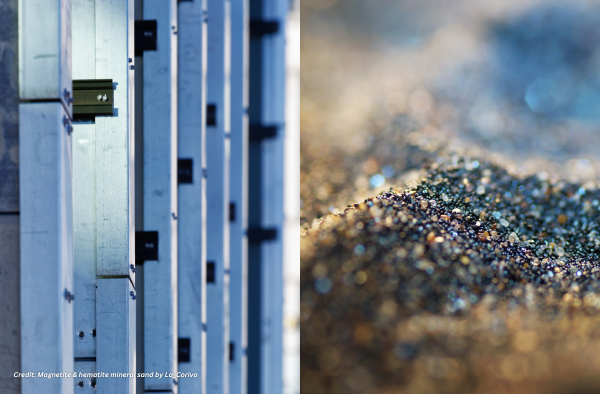GFG Alliance prepares for industrial revolution
Share

The shift from hematite to magnetite is positioning the GFG Alliance-owned Whyalla Steelworks at the centre of a new industrial era. GFG’s mining division, SIMEC Mining, is increasing the output of magnetite iron ore at its mines in the Upper Spencer Gulf. The company aims to utilise renewable energy and hydrogen to create carbon-neutral steel by 2030.
The metals industry is currently grappling with a complex challenge. Steel and aluminium production contribute to over 10% of worldwide CO2 emissions. With economic growth, the demand for steel and aluminium is expected to increase significantly over the next three decades. In response, several countries are implementing laws to achieve carbon neutrality by 2050. Amid increasing global concerns about pollution from the coal-based steel industry, GFG is shifting its focus to utilising high-quality magnetite iron ore to create hydrogen steel, which boasts zero emissions.
According to environmental scientist Victoria McCarron from SIMEC Mining, the shift from coal to magnetite is reshaping the story of her hometown, Whyalla. “Last year we closed the coke ovens – a single piece of infrastructure that was burning coal and making it into coke – so we’re already in the process of shifting towards being a greener site,” she says. “If we are using a resource that will allow for the production of green steel, and the use of hydrogen energy to produce that, then it will ultimately help to reduce carbon output, which will change people’s perceptions.”
McCarron oversees the Iron Knob, Iron Baron, and South Middleback Ranges mines, ensuring environmental compliance within the Programmes for Environment, Protection, and Rehabilitation regulations. She is excited about the prospects that magnetite mining will offer. “I directly help with the magnetite expansion with regard to the ecological understanding and implications,” she says. “Magnetite is much more energy efficient and a better product. If the project takes off, we’re looking at another 20 years of mining out there, so that’s long-term security and opportunities for not just people here but people throughout the state and the country.”
McCarron assumed the position at SIMEC Mining in 2022, following ten years of academic pursuit in Adelaide. “It was such a great opportunity for me – it opened doors that I didn’t think were possible,” she says. “A couple of years ago, I didn’t think I could buy a house but last year I did and it is much more affordable than in Adelaide.”
Residing in Whyalla has also presented opportunities for lifestyle adjustments. “You don’t have to think, ‘Oh, I have an hour’s commute to get to work’. For the most part it is a simple, five-minute drive to get anywhere. Catching up with people, it’s just one or two messages rather than the three months-long group chat trying to plan a hike, and you can spend weekends doing sport. There is such a community here that you can’t really get in cities. You know everyone. I feel so much more relaxed here.”
Whyalla is poised to become a hub for large-scale magnetite mining, offering employment opportunities for both local residents and newcomers to the area for years to come. “There are so many different projects that there is going to be a world of jobs, with all different skillsets required,” McCarron says.
“I think the locals are excited. There will still be job opportunities for people who live here so it adds to their security. It’s also going to bring people in, which will lead to developments in infrastructure and those flow-on effects for the economy. I’m definitely excited.”
State Prosperity Project benefits
Whyalla hydrogen job opportunities
An upcoming project will establish a cutting-edge renewable hydrogen power station, electrolyser, and storage facility in the vicinity of Whyalla. Over 70% of South Australia’s current energy supply is sourced from renewable sources. With the world’s largest hydrogen plant and a skilled local workforce, these resources can be utilised to generate renewable hydrogen. The project is set to become operational in early 2026, with the potential to create thousands of job opportunities.
Benefits: Promote South Australia’s shift to clean energy and stimulate other hydrogen initiatives in progress.
Hydrogen export hub at Port Bonython
Expanding upon the current hydrocarbon-based export facility, Port Bonython is poised to become South Australia’s initial extensive clean hydrogen production hub for both international and local markets. This project plays a key part in South Australia’s initiative to establish a presence in the worldwide hydrogen market.
Benefits: Establishment of a significant export terminal for hydrogen. An impressive $140 million has been allocated for the enhancement of common user infrastructure. Encourage the growth of local businesses and attract new investments.
Revolutionizing northern water systems
The South Australian Government is currently looking into the progress of the Northern Water project, which aims to provide a climate-independent water supply for the Far North, Upper Spencer Gulf, and eastern Eyre Peninsula regions. Highlighting a 260 ML/day desalination plant and a 600km pipeline network, Northern Water aims to distribute water throughout the region to bolster various industries, such as the hydrogen sector and the state’s copper and other critical mineral mining operations in the far north of SA.
Benefits: By utilising alternative water resources, like the Murray River and the Great Artesian Basin, industries can reduce their dependence on traditional sources and promote sustainable practices in hydrogen production, steel manufacturing, and mining.
Whyalla Steelworks
South Australia is at the forefront of the green steel movement, collaborating with the GFG Alliance, the company behind Whyalla Steelworks, to develop a competitive and eco-friendly industry. By converting the Whyalla steelworks from a conventional blast furnace to a contemporary electric arc furnace run on renewable energy, GFG hopes to achieve carbon neutrality by 2030. During the transformation process, a direct reduction iron plant will receive an abundant supply of more than 4 billion DRI-quality magnetite ores from the nearby Middleback Ranges, sourced by GFG. The South Australian Government has allocated $50 million, while the Australian Government has pledged $63.2 million to support the transformati
Benefits: Establish an industry that is both globally competitive and sustainable.
Port Augusta College Technical programs
The state government is building a new training-focused college to prepare Upper Spencer Gulf students for careers in regional industries like mining, renewable energy, manufacturing, construction, tourism, and health. An innovative new college is set to be constructed on the premises of Port Augusta Secondary College in collaboration with resource giant BHP. The partnership will involve co-designing courses and buildings. The Port Augusta site, set to open in 2025, is included in a $208 million initiative for five technical colleges throughout the state.
Benefits: Providing local students with the necessary skills to access high-demand jobs in the area.

Justin Lavadia is a content producer and editor at Public Spectrum with a diverse writing background spanning various niches and formats. With a wealth of experience, he brings clarity and concise communication to digital content. His expertise lies in crafting engaging content and delivering impactful narratives that resonate with readers.


Today’s Pick
11th Annual Aus Goverment Data Summit
April 1, 2025
7th Annual NZ Government Data Summit
May 7, 2025
3rd Public Sector Comms Week
May 14, 2025
Subscribe
We send emails,
but we do not spam
Join our mailing list to be on the front lines of healthcare , get exclusive content, and promos.
AI appointment Australia Australian boost boosts business businesses covid-19 cyber cyber attack cybersecurity cyber security data data breach data management defence Digital employment enhance enhances fraud funding governance government grants infrastructure Innovation Lockdown management new zealand NSW NZ online privacy public Public Sector queensland renewable energy scams security Social Media Technology telecommunications victoria
-

Understanding and building your digital strategy
Digital Government, Opinion
-

Featured Leader: Jamie Morse on multi-channel strategies for communication
Communications, Featured Leader
-

Featured Leader: Tegan Tembe of NSW Treasury on creating solid planning strategies and processes
Featured Leader
-

Wirraka Maya Health Service improves patient care with My Health Record
Learning
Show More-

Effects of ineffective communication in the workplace
Communications, Personal Development
-

7 ways you can enhance your personal development skills
News, Personal Development
-

5 advantages of working in the public sector
News, Personal Development, Professional Development
-

7 causes of communication issues in the workplace
Communications, News, Personal Development
Show MoreLast Viewed